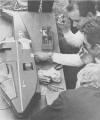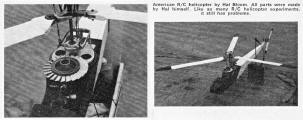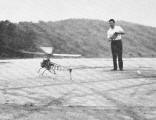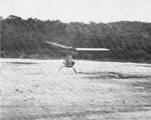RC Helicopter History - 1970
The end of the beginning
In Germany through January and February Dieter Schlüter tested out his new helicopter with 'single' flybar and was very pleased with the result. Harsewinkel was again coming up at the Whitsun weekend and he could have just displayed this prototype which would have been enough to prove it had finally been done. However, being a modeller he had to make it look like a real one and he also knew that the bigger it was the better; additionally, a 'military' model would have more of an appeal and so he built a model of the Bell Huey Cobra around his set of mechanics. He continued to practice until the 12th of April when the model tried to 'fly away' and this time he let it; thus the first RC helicopter circuit was achieved.
On then to Harsewinkel on the Whitsuntide weekend and this was to be a three day modelling extravaganza as it was also the tenth anniversary of the Ikarus company. So, barely 18 months after the first helicopter competition where it was considered that it would take many years to perfect, Dieter presented his helicopter to a waiting crowd.
The first official demonstration of my 'Bell Huey Cobra' in the slow flight competition. I was terribly nervous, but l flew the model through the measured course, marked out with ropes to form a tunnel. It was obvious that l was really in control, and everyone was very excited. The only thing l had not attempted was backwards flight and l lacked the courage and the experience. I was constantly encouraged by the many cries of '. . . we want to see the helicopter. ..' and after an involuntary landing on a beer tent roof, l spontaneously announced a record attempt. Witnesses were drummed up, stop watches found, and then l flew the first World Record of 10 minutes and 36 seconds of uninterrupted flight. What does it matter that the record was not officially recognized because of incorrect procedure? (it was not notified) -I knew that it was successful, and thousands had seen it. What more could l ask for! And l was without doubt the first person in the world to do it.
Interesting comment about the notification as records do not show the Burkam flight as having previous notification to the FAI, it was apparently ratified because the AMA had submitted it.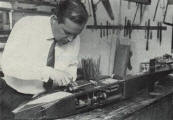
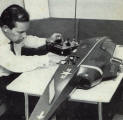



World record attempts at Altdorf near Nürnberg.
On 20th June 1970 I heeded all the regulations and set up an officially recognized world record time of 27 minutes and 51 seconds of uninterrupted duration, and distance in a closed circuit of 11.5km. There were a few problems beforehand: It was so warm that the worm drive overheated. I fixed a 200cc tank on the side of the fuselage, into which the gearbox oil was pumped, where it was cooled by the rotor's downwash. The fuel tank was enlarged to 1 litre, but l could only carry 0.8 litres to stay within the 5kg weight limit. Otherwise l could have flown for longer; that was no problem. But l was quite satisfied as it was.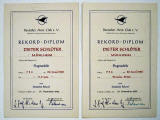
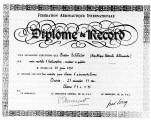

Dieter's Diplomas for duration and distance.
A simple duration time only would have been simply to achieve however a distance record was different.
In his own words, Dieter Schlüter reports: "When I came to Nürnberg I had about 6 hours of experience with the new model. Starting the plane was done in the presence of official witnesses of the German Aero Club at the flying site. At about 150 meters distance there was a new stretch of Autobahn which was not yet open to traffic. The civil engineers had marked the 500-meter distance. To differ with witnesses, I went to this part of the Autobahn while the model flew over-head. Once on the Autobahn, I hovered the model and climbed into an open car. Then I began flying over the 500-meter distance. After rounding one pylon, I was driven by the car in the direction of the second pylon. After that had been rounded, we turned around and followed the model. This flight was accomplished at an altitude of between 20 and 40 meters. After flying 23 times through the course I left the car and asked the witnesses to be present at the landing area where I landed at exactly the same spot as take off had occurred. The record was acknowledged by the witnesses and official personnel in attendance and has been submitted to the German Aero Club. Official recognition from the FAI as a world record in the F3C Class is expected within a short time."
Thus from the one flight he achieved both distance and endurance which was considered the first internationally 'recognised' meaningful world records.
Prototype Cobra - Technical description in Dieters own words of his model Cobra taken at the time of the world record.
At this meeting was Horace Hagen who was over from the USA on a months holiday and he had the opportunity to see Dieter's 8mm film of his early experimental flights. He was fascinated by the early footage and realised that Dieter could have claimed the duration record in 1968 however, Dieter himself felt that his shorts hops of around 10 seconds did not demonstrate effective control. At this point Horace put his name down for one of the first batch of fifty 'hand made' kits of the cobra that dieter was going to produce.
Over in the USA.
Things were also moving on a pace in the USA as the above model by Hal Bloom shows. The caption is not clear on the problems and the photo's are not that good either but, it would seem that the main rotor does not appear to have (much?) stabilisation so I would suspect that it was control of the main rotor that was the problem..
 Gene Rock and tethered garage hovering.
Gene Rock and tethered garage hovering.
April 17 1970 and Gene Rock was also continuing his experiments with his electric powered single rotor design helicopter driven by a motor from an electric drill. Needed the umbilical 'tether' to provide the motor power??

However, at the SLOB contest?? (World Engines Manufacturers Invitational??) in the USA held on the 19th of September, David Gray successfully demonstrates his 'contra-rotating' helicopter; though it took many months before this achievement was presented to the public as noted with the copy date for the magazine cover.
Historic note - in 2009 David Grey was inducted into the Model Aviation hall of fame. Unfortunately this was inaccurately reported as the AMA hall of fame and also credited with inventing and flying the first RC helicopter with his 1970 flight. However, as you can see having read to this point, that is not quite right and David himself has only ever acknowledged being credited as having the first successful RC helicopter designed in the USA. It turns out that his certificate stated, quote;
"Such High Honor is Being Accorded in Due Recognition of Distinguished Achievement and Meritorious Service of Outstanding Significance Which Have Furthered the Interest of Model Aviation"
His award was for his contribution in the USA and mainly through his association with Dub-Ro for making home grown USA RC helicopters popular; so the moral of the story is not all you read is true........
So taking a step back at this point in time, who was David Grey? His biography of the early years from the 2009 Model aviation article (ignore the first line as per the reason above) shows that he was an active and enthusiastic modeller from a very young age. However, like most other pioneers he carried out his experimenting in private but unlike Dieter did not document everything and also, until he could confidently display his model, he bided his time which is why he suddenly appeared to come 'out of nowhere'.
Meanwhile in Japan.
Shinya Fujiyama of Hiroshima
Five years of experimentation and as the caption says, he had succeeded in achieving controlled flight. Interesting three bladed head with a rotor spans of 1400 mm (55 inch) and wooden blades with a Clark Y section changing to symmetrical section at the tips; note that tail rotor is a 'standard' aero type two blade propeller so not quite sure on the method used for rotation control... Head utilises a three legged 'Lockheed' stabilizer system and engine is a Enya 60-III. The hovering above the assistant and close to trees implies a good level of control; whatever happened to Shinya as this is the only mention of him or his helicopter I can find???
Start of a new decade and also the introduction to a new era for Radio Controlled aircraft with Dieter Schlüter's successful demonstration of controlled flight with his model Cobra. Many other experimenters were also getting close with some like John Drake of the UK already on the right track and others like Dave Gray of the USA and Shinya Fujiyama of Japan demonstrating levels of success. However, as the 'first', Dieter was inundated with request for drawings and so went into kit production of a revised layout Cobra; the first of which were to be despatched before the end of the year.

